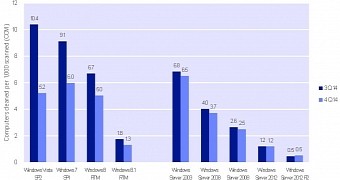Windows has always been the preferred target for malware creators across the world, mostly because it's the number one operating system on the desktop, but the latest versions of the OS released by Microsoft make it a lot harder to infect a computer.
That's what data collected by Microsoft and included in latest Security Intelligence Report claims, with Windows 8.1 currently having the lowest malware infection rates of all Windows versions on the market.
The graph included in this article compares malware infection rates in Q3 and Q4 2014, and Windows 8.1 gets the best score in both cases.
Windows Vista, on the other hand, isn't doing very well as far as the number of malware infections is concerned, so Microsoft says that the older your Windows version is, the bigger the chances to get the computer infected.
Microsoft explains how it analyzed the data:
“This data is normalized, meaning the infection rate for each version of Windows is calculated by comparing an equal number of computers per version; for example, comparing 1,000 Windows Vista Service Pack 2 (SP2) based systems to 1,000 Windows 8.1 based systems in the fourth quarter of 2014 we can see 5.2 Windows Vista based systems infected with malware compared to 1.3 Windows 8.1 systems infected.”
“In percentage terms, that’s equivalent to 0.52% of Windows Vista based systems (5.2/1,000*100 = 0.52) compared to 0.13% of Windows 8.1 based systems (1.3/1,000*100) infected with malware.”
New and more effective anti-malware technologies
Newer versions of Windows come with improved anti-malware protection, and Windows 10, the new OS due out in the summer, will include even more enhancements in this regard.
Windows 8.1, for instance, comes with Windows Defender, a full-featured security solution that provides anti-malware and real-time protection, installed by default, whereas users of Windows Vista and Windows 7 need to manually install such software on their PCs. Microsoft does offer them Security Essentials free of charge, but this needs to be manually deployed on every system.
At the same time, Windows 8.1 integrates features such as SmartScreen Filter in Internet Explorer and Windows to block malicious apps from running on a computer, as well as User Account Control (UAC) to make sure that apps cannot launch with administrator privileges until you specifically allow them to.

 14 DAY TRIAL //
14 DAY TRIAL //